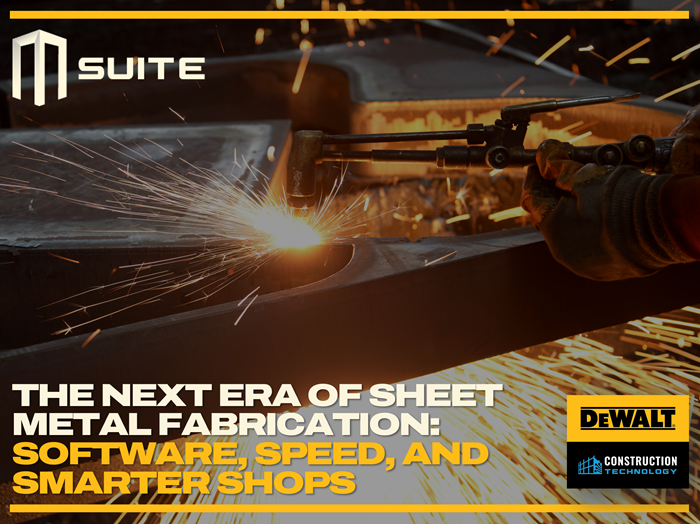Why Sheet Metal Fabrication Software Is Reshaping Construction Projects
Sheet metal fabrication is the backbone of HVAC, construction, and industrial projects. Yet with shrinking schedules and tighter budgets, many shops are still held back by spreadsheets, whiteboards, and paper drawings. Modern sheet metal fabrication software is changing that, giving contractors faster, smarter, and more predictable ways to manage their shops.
By moving from manual to digital workflows, fabricators can increase throughput, reduce rework, and improve profitability—all while meeting today’s higher demands for speed and precision.
1. The Pressure on Fabrication Shops
Construction productivity has only grown 1% annually over the past 20 years (McKinsey). For sheet metal fabricators, that means every hour and every spool matters. Without efficient processes, schedules’ slip and profit margins shrink.
Sheet metal fabrication software allows shops to operate more like advanced manufacturing facilities: streamlined, data-driven, and collaborative.
2. Centralizing the Workflow
When drawings, PDFs, and emails live in separate silos, communication breaks down. Fabricators risk building from outdated plans or duplicating effort.
Software like MSUITE solves this by centralizing every instruction—whether from BIM, CAD, or PDF—into one accessible platform. Shop teams see exactly what needs to be built, in the right order, without chasing paperwork.
3. From BIM to Fabrication with Ease
Translating BIM models into shop-ready work packages has always been a time-consuming pain point. Manual conversions often introduce errors or slow production.
With sheet metal fabrication software, BIM models flow directly into fabrication. Work packages are automated, accurate, and ready to hit the floor—saving hours and ensuring better coordination across project teams.
4. Real-Time Production Tracking
Shops thrive on visibility. Without it, bottlenecks remain hidden until they cause costly delays.
Fabrication software enables real-time production tracking. Managers can see live updates on spools completed, hours logged, and overall progress. According to Dodge Construction Network, digital tracking improves shop productivity by 25–30% compared to manual methods (Dodge Report).
5. Reducing Rework, Improving Accuracy
Rework drains time and budget, accounting for up to 5–15% of total project costs (Autodesk & FMI).
Digital workflows reduce rework by eliminating outdated drawings, unclear instructions, and miscommunication. With standardized digital packages, every fabricator works from the same clear instructions, ensuring accuracy the first time.
6. Scaling Prefabrication
Owners and GCs are increasingly demanding that contractors utilize prefabrication to meet accelerated schedules. That means sheet metal shops must fabricate more assemblies offsite and deliver with precision.
Fabrication software enables this scale by providing visibility and automation. Teams can build repeatable processes that improve consistency while speeding up output.
7. Controlling Materials and Labor
Profitability in fabrication depends on managing two critical resources: labor and materials. Software dashboards track usage in real time, giving managers insights into costs, waste, and productivity.
For example, shops can analyze labor hours per duct assembly or material consumption by job. This helps leaders bid more competitively and manage projects with confidence.
8. Case Example: Digital Workflows in Action
One contractor adopted MSUITE FAB to replace manual whiteboard tracking. The shift to digital dashboards gave leaders real-time visibility across the shop.
Results included:
- Faster fabrication throughput
- Improved schedule certainty
- Stronger field coordination
By connecting BIM, fabrication, and field workflows, the contractor improved both efficiency and accountability.
Read the full case study here.
9. Preparing for the Next Generation
The future of fabrication goes beyond visibility. By capturing accurate shop data today, contractors position themselves for AI-driven forecasting and machine learning insights tomorrow.
Imagine software that predicts labor shortages, identifies material risks, and suggests process improvements before issues appear. The foundation for that future starts with digital adoption now.
10. Steps to Get Started
Adopting sheet metal fabrication software doesn’t need to be overwhelming. A phased rollout builds confidence, establishes quick wins and sets your shop up for tracking ROI.
Smart Steps to Success:
- Centralize shop instructions and drawings.
- Implement real-time production tracking.
- Connect BIM directly to fabrication workflows.
- Monitor labor and material metrics.
- Scale to multiple shops and projects.
Conclusion: Software as a Competitive Advantage
In today’s competitive market, sheet metal fabricators who rely on manual tools risk falling behind. Sheet metal fabrication software delivers faster throughput, fewer errors, and stronger profitability—giving contractors a clear edge.
MSUITE FAB helps sheet metal fabricators bridge the gap between BIM, shop, and field. For teams ready to deliver with confidence, the next era of fabrication starts now.
Learn more about MSUITE FAB
Frequently Asked Questions About Sheet Metal Fabrication Software
Q1: What is sheet metal fabrication software?
Sheet metal fabrication software is a digital platform that manages the entire fabrication workflow. It centralizes drawings, automates work packages from BIM, tracks production in real time, and gives managers visibility into labor and materials.
Q2: How does BIM help sheet metal fabrication?
BIM (Building Information Modeling) provides a 3D model of the project. Fabrication software connects directly to BIM, turning models into shop-ready instructions. This reduces errors, speeds up fabrication, and ensures field teams install exactly what was designed.
Q3: What are the benefits of sheet metal fabrication software?
- Faster shop throughput
- Real-time production tracking
- Fewer errors and rework
- Better labor and material cost control
- Seamless coordination between shop and field
Q4: Is sheet metal fabrication software hard to implement?
No. Most contractors start with a small pilot program to digitize one shop or workflow. Once teams see the benefits—like time saved and fewer mistakes—they scale software across more projects and facilities.
Q5: Can fabrication software increase profitability?
Yes. By reducing waste, improving accuracy, and providing clear labor and material metrics, fabrication software helps contractors bid smarter, deliver faster, and protect profit margins.









